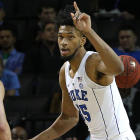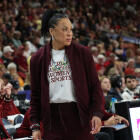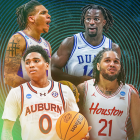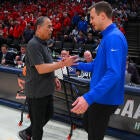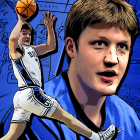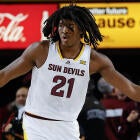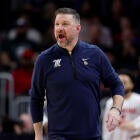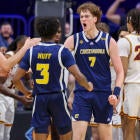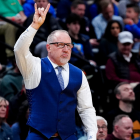Some NBA Drafts have a consensus No. 1 pick. In 2003, it was LeBron James. In 2012, it was Anthony Davis. But in 2018 there is no such person -- because there are at least three prospects most people believe could reasonably go No. 1. The first is Arizona's Deandre Ayton. The second is Real Madrid's Luka Doncic. And the third is the player I prefer -- Duke star Marvin Bagley III.
I'm still on Bagley.
Yes, I know he's not as physically imposing as Ayton. And I know he's not doing unprecedented things for an 18-year-old in Europe. But he's the most consistent great player in college basketball and forever capable of posting silly numbers in the normal flow of a game. Take Thursday's ACC tournament quarterfinal, for instance. Bagley got 33 points and 17 rebounds in an 88-70 victory over Notre Dame. He was 13-of-20 inside the arc. He was 2-of-3 from beyond the arc. He dominated all over the court and looked terrific while doing it.
Simply put, I'm not passing on MB3.
He's the rare elite talent who also plays as hard as, if not harder than, anybody. And if the lottery odds go the way they're supposed to go, I can't wait to watch him play between Mike Conley and Marc Gasol in Memphis next season.
| 1 | |
| Marvin Bagley III | Duke | Fr. | PF Bagley has been spectacular this season -- averaging a team-high 20.7 points and a team-high 11.2 rebounds in 33.0 minutes per game. He is the ACC Player of the Year. So the 6-11 freshman has proven to be both a great prospect and terrific player -- and the fact that he plays with great energy, almost always, is another positive sign. As I've said and written many times, I understand and respect the arguments for Ayton and Doncic. But I've forever preferred Bagley, and nothing that's happened this season has altered my position. There's just no way, barring injuries, that he's not a high-level NBA player for a long time because of his physical gifts, unique skillset and better-than-good motor. | |
| 2 | |
| Deandre Ayton | Arizona | Fr. | C Ayton is the main reason Arizona won the Pac-12 by two games and finished the regular season 24-7. The 7-1 freshman is averaging 19.9 points and 11.4 rebounds -- and he was named the Pac-12 Player of the Year in early March. His 7-5 wingspan allows him to alter shots at the rim and even away from the basket -- meaning he's not just an offensive weapon. And though Ayton has not shot well from beyond the arc, the ability to do so is there -- which is why he projects as a future floor-spacing center who punishes opponents from different places on the court. | |
| 3 | |
| Luka Doncic | INTL | SG Doncic is a wing with size who has solidified his reputation as one of the best young European prospects ever. The 6-8 Slovenian is averaging 17.0 points, 5.0 rebounds and 4.5 assists for Real Madrid, which is historically great for an 18-year-old playing against older and more developed men. His versatility allows him to play four different positions, meaning Doncic is a fit basically anywhere. Some front offices have him going as high as No. 1 overall. Almost nobody thinks he goes any lower than No. 3. | |
| 4 | |
| Mohamed Bamba | Texas | Fr. | PF Bamba finished the regular season averaging 13.0 points, 10.6 rebounds and 3.8 blocks in 30.8 minutes per game while earning that "unicorn" label from some -- including himself. The 7-foot forward with a 7-9 wingspan alters nearly everything around the rim and projects, at worst, as a future First Team All-Defense member. At best, he'll develop enough offensively to join Golden State's Kevin Durant on the list of one-and-done Texas alums who went on to become franchise-changing superstars. | |
| 5 | |
| Michael Porter Jr. | Missouri | Fr. | SF Porter had back surgery in November that robbed him of almost all of his first (and almost certainly last) season of college basketball. And that's too bad. But it isn't expected to cost him too much as it relates to the NBA Draft. The 6-10 wing probably won't slip much farther than this for the same reasons an injured Joel Embiid didn't slip far in the 2014 NBA Draft, i.e., because when you can get a possible No. 1 pick with the third or fourth of fifth pick it's often wise to do it. Obviously, Porter's situation will be decided by what doctors see or don't see during a physical. But if there are no medical red flags, the Missouri product should go in the top half of the lottery. | |
| 6 | |
| Jaren Jackson Jr. | Michigan State | Fr. | PF Jackson has been a projected lottery pick for at least a year now. But the 6-11 forward has shown things during his freshman season that have some thinking he's likely more of a top-half-of-the-lottery guy than somebody who will be available in the teens. He'll enter the NCAA Tournament averaging 11.3 points, 5.8 rebounds and 3.2 blocks while shooting 39.6 percent from 3-point range in 22.2 minutes per game. So what we're talking about here is a long and athletic big who consistently makes shots from the perimeter. He's a special and unique talent who is now Michigan State's best NBA prospect. | |
| 7 | |
| Collin Sexton | Alabama | Fr. | PG Sexton's Crimson Tide took a bad turn late and closed the regular season on a five-game losing streak that put their NCAA Tournament hopes in real jeopardy. But it would be foolish to suggest Sexton is the main issue -- though him missing 15 of his 17 3-point attempts in that stretch, and lowering his 3-point percentage to 30.6 on the season, was both problematic for Alabama and enlightening for NBA front offices. Nobody questions the 6-3 point guard's athleticism or aggressiveness -- and it was on display in the final seconds of Alabama's win over Texas A&M in its SEC Tournament opener. But his inability to consistently take over games at this level, and consistently make shots, is a slight source of concern. | |
| 8 | |
| Trae Young | Oklahoma | Fr. | PG Young went from college basketball's biggest star to the best player on a team that went 2-9 in what probably will be his final 10 games in college. That was neither good nor expected. But most NBA people believe that has more to do with Young's teammates than Young. Opponents started daring anybody but the 6-2 point guard on OU's roster to beat them, and they couldn't. So everything became more difficult -- which is why Young's 3-point percentage dipped to 36.1. But he's still averaging 27.4 points and 8.8 assists. And he still has incredible vision and playmaking skills. And he'll still be a top 10 pick. | |
| 9 | |
| Wendell Carter Jr. | Duke | Fr. | PF Is it possible to have a great freshman season but still be overshadowed by a teammate? Yes. And that's exactly what's happened to Carter -- who is averaging 14.1 points, 9.5 rebounds, 2.2 blocks and 2.1 assists in 27.5 minutes per game for a Duke team that closed the regular season by winning six of its final seven. Carter's biggest problem, frankly, is that he's not Bagley, who is a better player and prospect. But the 6-10 forward is still a very good player and very good prospect. And he's the reason why Duke should have two top-10 picks in June. | |
| 10 | |
| Mikal Bridges | Villanova | Jr. | SF I'm not sure anybody, outside of Young, has helped himself more this season with NBA people than Bridges -- who is averaging 17.6 points and 5.5 rebounds while shooting a career-best (and impressive) 42.0 percent from 3-point range in 32.5 minutes per game for a Villanova team that finished the regular season 27-4. More than anything, the 6-7 wing is making "pro shots" more regularly than ever and doing most of the things any NBA team would want him to do at the next level. His ability to guard multiple positions makes him somebody who could theoretically contribute to a playoff team on Opening Night. | |
| 11 | |
| Miles Bridges | Michigan State | Soph. | SF/PF Bridges has been criticized by an ESPN analyst for having "no game." But that ESPN analyst doesn't run an NBA franchise. So it would be silly to think it'll keep the Michigan State sophomore from becoming a lottery pick after leading the Spartans to a Big Ten regular-season title. Bridges is averaging 16.9 points, 6.9 rebounds and 2.8 assists as a 6-7 athletic combo forward who also makes 36.9 percent of his 3-point shots and 88.3 percent of his free-throw attempts. Sure, like everybody else, I wish Bridges were three inches taller. But he's not. And yet he still projects as a meaningful NBA player, according to most. | |
| 12 | |
| Kevin Knox | Kentucky | Fr. | SF Knox closed the regular season by reaching double figures in points in eight consecutive games while solidifying himself as Kentucky's leading scorer. The 6-9 forward is averaging 15.7 points and 5.3 rebounds -- and shooting 35.0 percent from 3-point range. He projects as a combo forward with good size who can guard multiple positions and just generally help teams in a variety of ways that matter. | |
| 13 | |
| Lonnie Walker | Miami | Fr. | SG Walker's freshman season didn't get off to a great start -- evidence being how he only averaged 8.1 points in 20.9 minutes per game through Miami's first 15 contests. But the 6-4 freshman averaged 14.0 points in Miami's final five regular-season games to remind NBA scouts why they view him as a strong-framed shooting guard at the next level. Yes, he's only shooting 35.8 percent from 3-point range. But, remember, Walker shot 40.0 percent from beyond the arc two summers ago in the EYBL. So his lower percentage isn't concerning. | |
| 14 | |
| Robert Williams | Texas A&M | Soph. | PF Williams has not had a great (or even good) sophomore season considering he's averaging fewer minutes, fewer shots and fewer points -- and his free-throw attempts and free-throw percentage are also both down. But the 6-9 forward still has attributes that make him attractive to NBA front offices, and he still projects as an athletic rebounder and shot-blocker who could end up just like fellow Texas A&M alum DeAndre Jordan -- which is to say someone who is a better NBA player than college player. | |
| 15 | |
| Anfernee Simons | IMG ACADEMY | SG Simons is a consensus top-10 prospect in the Class of 2018 who is eligible for the 2018 NBA Draft because he's one year removed from high school graduation and will turn 19 this calendar year. The 6-4 combo guard at IMG Academy in Florida is a nice athlete who shoots it well. If he attends college, Florida and Tennessee are considered the favorites. If not, absolutely, he could go in the top 20. | |
| 16 | |
| Dzanan Musa | INTL | SF Musa is a 19-year-old Bosnian who is averaging 20.2 minutes per game for Cedevita in the Adriatic League. The 6-8 wing has long had a reputation with scouts as potential quality scorer in the NBA. The only concern is whether he's a good-enough athlete, and mature enough, to guard his position and flourish in general when he moves to the United States. | |
| 17 | |
| Shai Gilgeous-Alexander | Kentucky | Fr. | PG Gilgeous-Alexander was a rare sub-30 high school prospect for Kentucky. But he's emerged as the Wildcats' second-leading scorer and one of their most reliable players. The 6-6 combo guard is averaging 13.2 points and 4.9 assists in 32.9 minutes per game. He doesn't take a lot of 3-pointers. But he does make 39.5 percent of his attempts. | |
| 18 | |
| Troy Brown | Oregon | Fr. | SG Brown developed a reputation in high school as somebody who values defense and could reasonably play at least three positions at the collegiate level, and he's shown flashes of that this season. The 6-7 freshman is averaging 11.8 points and 6.5 rebounds in 31.5 minutes per game. If he can develop a consistent 3-point shot -- Brown is only shooting 30.1 percent from beyond the arc this season -- he'll be capable of providing the versatility NBA franchises crave while playing both forward positions at the next level. | |
| 19 | |
| Daniel Gafford | Arkansas | Fr. | PF | 6-11 Gafford is a 6-11 big with a 7-2 wingspan who dunks everything and is just generally ferocious around the rim. He's averaging 12.1 points, 6.2 rebounds and 2.2 blocks for a team that finished the regular season 21-10. And he should be a top-20 pick even though he was just a borderline top-40 prospect coming out of high school. | |
| 20 | |
| Landry Shamet | Wichita St. | Soph. | PG Wichita State has made a habit of developing guards into NBA players -- most notably Fred VanVleet and Ron Baker. Shamet should be next. The 6-4 sophomore is averaging 14.6 points and 5.2 assists for a WSU team that finished the regular season 24-6. He's shooting 44.0 percent from 3-point range and taking nearly six threes per game. | |
| 21 | |
| Khyri Thomas | Creighton | Jr. | SG Thomas is the reigning Big East Defensive Player of the Year -- one who uses a 6-11 wingspan on a 6-3 frame to get into passing lanes and, in other ways, just make things difficult on opposing guards. He's also averaging 15.5 points and shooting 42.5 percent from 3-point range. So anybody looking for a 3-and-D wing will give Thomas a serious look. | |
| 22 | |
| Mitchell Robinson | N/A | Fr. | C Robinson made a mess of his college situation by enrolling at Western Kentucky and then, just two weeks later, leaving campus and asking for a release. Then the 7-foot forward never enrolled in another school -- meaning he's not playing competitive basketball anywhere right now. That's neither ideal nor smart. And it's possibly a red flag. But there's no guarantee it'll cost Robinson much on draft night. In fact, it's actually reasonable to think it could help him go in the first round given that he never ran the risk of being exposed in a college game between before someone spends a draft pick on him. | |
| 23 | |
| Grayson Allen | Duke | Sr .| SG Allen spent much of this season in relative anonymity. But he had a four-game stretch in February where he averaged 23.8 points and 4.5 made 3-pointers per game while reminding scouts why he's an intriguing NBA prospect. The 6-5 guard is a slasher and shooter who has mostly alleviated any concerns anybody might've had about his on-the-court behavior last season. | |
| 24 | |
| Chandler Hutchinson | Boise State | Sr. | SF Hutchison is having the best season of his four-year college career while establishing himself as a first-round talent. The 6-7 Mountain West star has all the tools necessary to be a quality NBA wing. He's averaging 19.5 points, 7.6 rebounds and 3.5 assists in 30.9 minutes per game. | |
| 25 | |
| Keita Bates-Diop | Ohio State | Sr. | SF Bates-Diop went from averaging 9.7 points as a junior to 19.4 points as a senior and improved in basically every way, which is why Ohio State spent much of this season nationally ranked and finished tied for second in the Big Ten regular-season standings. Not every player who returns to school to "improve his NBA stock" actually does. In fact, most don't. But Bates-Diop clearly did. | |
| 26 | |
| D'Anthony Melton | USC | Soph. | PG-SG Melton is a nice combo-guard prospect who was sidelined this preseason by an ongoing FBI investigation. So that's not ideal. But the 6-3 sophomore still has a chance to go in the first 30 picks. And if he slips into the second round, for whatever reason, multiple franchises will be trying to move up to grab him. | |
| 27 | |
| Bruce Brown Jr. | Miami | Soph. | SG A lot of people projected Brown to have a breakout season. But it didn't really happen considering he's playing more minutes and taking more shots but shooting a worse percentage from both inside and outside of the arc. His free-throw percentage is also down. And now he's sidelined with a broken foot. All that said, the 6-3 guard remains worthy of a first-round flyer because he projects as the type of tough defender NBA franchises need on the perimeter. | |
| 28 | |
| Shake Milton | SMU | Jr. | PG-SG Milton missed SMU's final nine games of the regular season with a hand injury, and the Mustangs went 1-8 in his absence. So that should tell you how much he meant to what would've otherwise been a borderline NCAA Tournament team. Prior to the injury, Milton was shooting 43.4 percent from three-point range and averaging a career-high 18.0 points, 4.7 rebounds and 4.4 assists. His ability to play on or off the ball should serve him well in the NBA. | |
| 29 | |
| Devonte' Graham | Kansas | Sr. | PG Graham, just like Frank Mason before him, went from an unheralded recruit to the Big 12 Player of the Year to a legitimate NBA prospect in a four-year span. The 6-2 point guard finished the regular season averaging 17.6 points, 7.2 assists and 4.0 rebounds in 37.4 minutes per game while shooting 42.3 percent from 3-point range. He's the main reason, if not the only reason, Kansas won a 14th straight Big 12 title. | |
| 30 | |
| Killian Tillie | Gonzaga | Soph. | SF Tillie is the latest Gonzaga frontcourt player to develop into a possible first-round pick, thanks to the fact that he's a 6-10 sophomore who is shooting 50.0 percent from 3-point range. The French import made 13 of 14 3-point attempts in three games during the West Coast Conference Tournament. He helped the Zags win 30 games for the third time in four years. | |
![[object Object] Logo](https://sportshub.cbsistatic.com/i/2020/04/22/e9ceb731-8b3f-4c60-98fe-090ab66a2997/screen-shot-2020-04-22-at-11-04-56-am.png)































